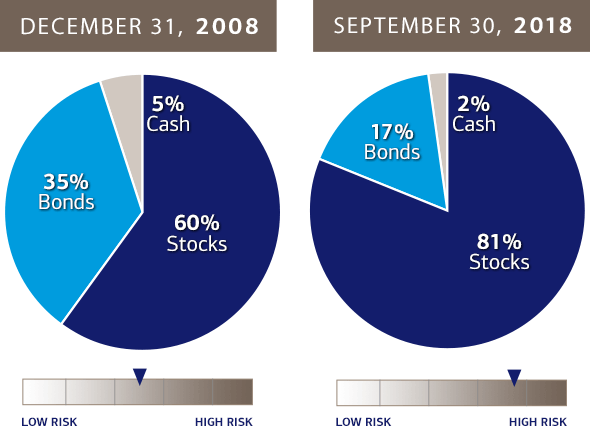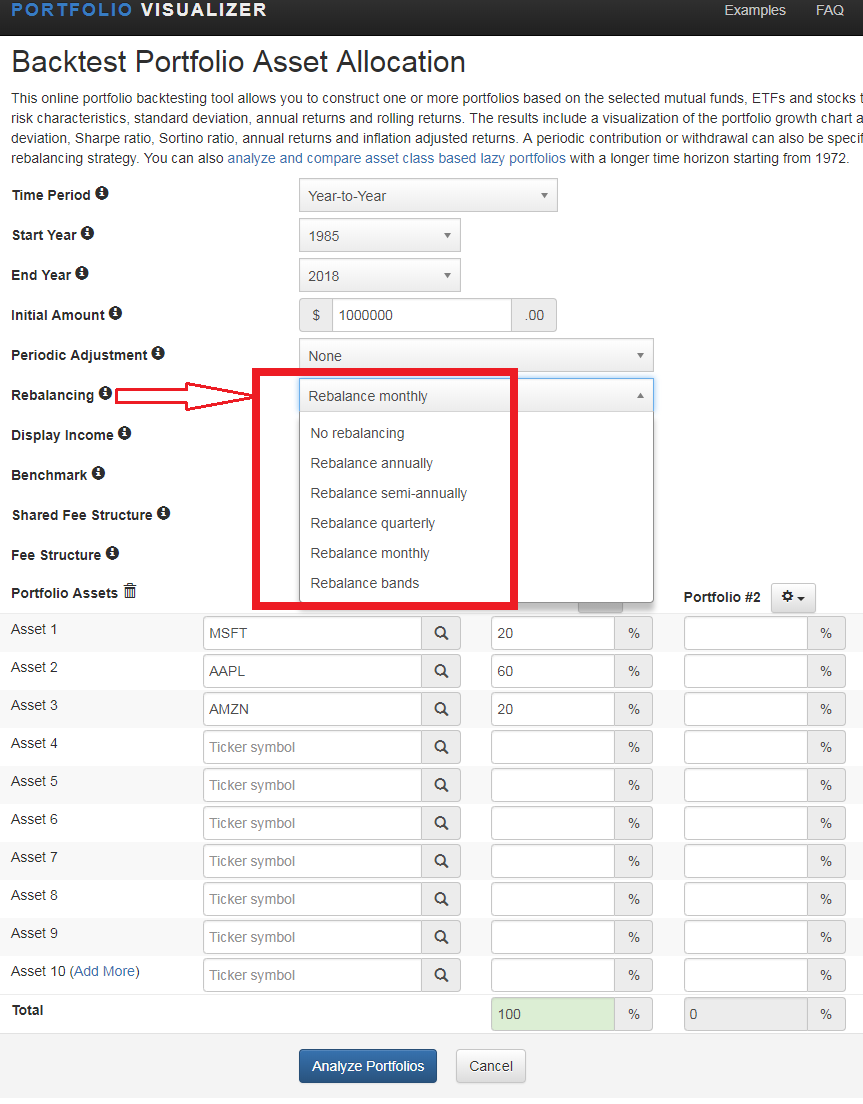Add Auto-Rebalance Portfolio Monthly??? (Read More...)
Hi, I’m doing some MT4 backtests with long term backtests and there is an Important feature I miss in QAnalyzer: Auto rebalance portfolio.
Each strategy grows in a different way and after few time, the portfolio is very different if we don’t update each underlying weight
We would need at least each year/Quarterly but much better if we could set "Auto Rebalance Portfolio" monthly. (see attached files)
-
Votes +14
-
Project QuantAnalyzer
-
Type Feature
-
Status Waiting for information
-
Priority Normal
-
Assignee Mark Fric
History
irod
04.12.2018 16:15Attachment Rebalancing Example.png added
I think it is an essential feature for any serious portfolio.
See some examples of many other Excellent tools (like Portfolio Visualizer). See Attached files.
There you can see how important is Rebalancing a portfolio. More examples:
1.- https://www.investopedia.com/investing/rebalance-your-portfolio-stay-on-track/
2.- https://www.investopedia.com/articles/stocks/11/rebalancing-strategies.asp
Please, I would be very glad if you could add this feature is soon as possible.
Thank you!!
irod
06.12.2018 17:49What Is Rebalancing?
Rebalancing is the process of buying and selling portions of your portfolio in order to set the weight of each asset class back to its original state. In addition, if an investor's investment strategy or tolerance for risk has changed, she can use rebalancing to readjust the weightings of each security or asset class in the portfolio to fulfill a newly devised asset allocation.
Blown out of Proportion?
The asset mix originally created by an investor inevitably changes as a result of differing returns among various securities and asset classes. As a result, the percentage that you've allocated to different asset classes will change. This change may increase or decrease the risk of your portfolio, so let's compare a rebalanced portfolio to one in which changes were ignored, and then we'll look at the potential consequences of neglected allocations in a portfolio.
Here's a simple example. Bob has $100,000 to invest. He decides to invest 50% in a bond fund, 10% in a Treasury fund, and 40% in an equity fund.
At the end of the year, Bob finds that the equity portion of his portfolio has dramatically outperformed the bond and Treasury portions. This has caused a change in his allocation of assets, increasing the percentage that he has in the equity fund while decreasing the amount invested in the Treasury and bond funds.
More specifically, the above chart shows that Bob's $40,000 investment in the equity fund has grown to $55,000—an increase of 37%. Conversely, the bond fund suffered, realizing a loss of 5%, but the Treasury fund realized a modest increase of 4%.
The overall return on Bob's portfolio was 12.9%, but now, there's more weight on equities than on bonds. Bob might be willing to leave the asset mix as it is for the time being, but leaving it for too long could result in an overweighting in the equity fund, which is riskier than the bond and Treasury fund.
The Consequences Imbalance
A popular belief among many investors is that if an investment has performed well over the last year, it should perform well over the next year. Unfortunately, past performance is not always an indication of future performance—a fact many mutual funds disclose. Many investors, however, remain heavily invested in last year's "winning" fund and may drop their portfolio weighting in last year's "losing" fixed-income fund. But remember, equities are more volatile than fixed-income securities, so last year's large gains may translate into losses over the next year.
Let's continue with
Bob's portfolio and compare the values of his rebalanced portfolio with the
portfolio left unchanged.
At the end of the second year, the equity fund performs poorly, losing 7%. At the same time, the bond fund performs well, appreciating 15%, and Treasuries remain relatively stable, with a 2% increase. If Bob had rebalanced his portfolio the previous year, his total portfolio value would be $118,500—an increase of 5%.
But if Bob had left
his portfolio alone with the skewed weightings, his total portfolio value would
be $116,858—an increase of only 3.5%. In this case, rebalancing would be the
optimal strategy.
However, if the stock market rallies again throughout the second year, the equity fund would appreciate more, and the ignored portfolio may realize a greater appreciation in value than the bond fund. Just as with many hedging strategies, the upside potential may be limited, but by rebalancing, you are nevertheless adhering to your risk-return tolerance level.
Risk-loving investors are able to tolerate the gains and losses associated with a heavy weighting in an equity fund, and risk-averse investors, who choose the safety offered in Treasury and fixed-income funds, are willing to accept limited upside potential in exchange for greater investment security.
How to Rebalance Your Portfolio
The optimal frequency of portfolio rebalancing depends on your transaction costs, personal preferences, and tax considerations—including what type of account you are selling from and whether your capital gains or losses will be taxed at a short-term versus long-term rate. Usually, about once a year is sufficient; however, if some assets in your portfolio haven't experienced a large appreciation within the year, longer time periods may also be appropriate.
Additionally, changes in an investor's lifestyle may warrant changes to his or her asset-allocation strategy. Whatever your preference, the following guidelines are the basic steps for rebalancing your portfolio:
- Record — If you have recently decided on an asset-allocation strategy that seems perfect for you and purchased the appropriate securities in each asset class, keep a record of the total cost of each security at that time, as well as the total cost of your portfolio. These numbers will provide you with historical data of your portfolio, so at a future date you can compare them with current values.
- Compare — On a chosen future date, review the current value of your portfolio and of each asset class. Calculate the weightings of each fund in your portfolio by dividing the current value of each asset class by the total current portfolio value. Compare this figure to the original weightings. Are there any significant changes? If not—and if you have no need to liquidate your portfolio in the short term—it may be better to remain passive.
- Adjust — If you find that changes in your asset class weightings have distorted the portfolio's exposure to risk, take the current total value of your portfolio and multiply it by each of the (percentage) weightings originally assigned to each asset class. The figures you calculate will be the amounts that should be invested in each asset class in order to maintain your original asset allocation.
Of course, you may want to sell securities from asset classes whose weights are too high, and purchase additional securities in asset classes whose weights have declined. However, when selling assets to rebalance your portfolio, take a moment to consider the tax implications of readjusting your portfolio. In some cases, it might be more beneficial simply not to contribute any new funds to the asset class that is overweighted while continuing to contribute to other asset classes that are underweighted. Your portfolio will rebalance over time without you incurring capital gains taxes.
The Bottom Line
Rebalancing your portfolio will help you maintain your
original asset-allocation strategy and allow you to implement any changes you make
to your investing style. Essentially, rebalancing will help you stick to
your investing plan regardless of what the market does.
irod
07.12.2018 17:58More information about why portfolios must be rebalanced

The illustration is hypothetical and does not reflect specific strategies we may have developed for actual clients. It is not intended to serve as investment advice since the availability and effectiveness of any strategy is dependent upon your individual facts and circumstances. Results will vary, and no suggestion is made about how any specific solution or strategy performed in reality. Source: https://www.merrilledge.com/article/how-and-when-rebalance-your-portfolio
irod
09.12.2018 17:55Subject changed from Auto rebalance portfolio to IMPORTANT - Auto Rebalance Portfolio (Please Vote to Set Priority to High!!!)
Attachment Rebalancing Example 2.png added
Subject changed from IMPORTANT - Auto Rebalance Portfolio (Please Vote to Set Priority to High!!!) to URGENT - Auto Rebalance Portfolio (Read More...)
Subject changed from URGENT - Auto Rebalance Portfolio (Read More...) to URGENT - Auto Rebalance Portfolio (Read More...)
Subject changed from URGENT - Auto Rebalance Portfolio (Read More...) to -> URGENT - Auto Rebalance Portfolio (Read More...)
Description changed:
Hi, I’m doing some MT4 backtests with long term backtests and there is an Important feature I miss in QAnalyzer: Auto rebalance portfolio.
Each strategy grows in a different way and after few time, the portfolio is very different if we don’t update each underlying weight
We would need at least each year/Quarterly but much better if we could set "Auto Rebalance Portfolio" monthly. (see attached files)
Subject changed from -> URGENT - Auto Rebalance Portfolio (Read More...) to Auto Rebalance Portfolio Monthly??? (Read More...)
See Comments above...

irod
13.12.2018 11:20Subject changed from Auto Rebalance Portfolio Monthly??? (Read More...) to Add Auto-Rebalance Portfolio Monthly??? (Read More...)
irod
15.12.2018 19:06mabi
17.12.2018 21:52irod
18.12.2018 13:18If we have for example 100 simple strategies in a long term, when we build a portfolio with them, we would need to rebalance them several times during the all portfolio history. In case we repeat each strategy each year (starting again with the initial balance and weight for each strategy, like rebalancing) the problem is that a lot of trades are forced to be closed at the end of each period and the final result is not valid.
mabi
19.12.2018 23:14irod
20.12.2018 00:54As you can see, Auto Rebalance porfolio is essential.
Tamas
14.01.2019 11:57Assignee changed from Mark Fric to Mark Fric
Priority changed from Low to Normal
Mark Fric
14.01.2019 12:30Status changed from New to Waiting for information
This functionality seems to be more suited for StrategyQuant.
irod
15.01.2019 00:41Hi Mark,
Sorry for inconvenience, This week I'm out of the office but We are preparing an email for you.
Well, It is clear that Quant Analyzer analyzes the behavior of a portfolio with several underlying assets over time and shows statistics based on that strategy. The error we see is when that portfolio is distorted over time because it can not adjust the weight of the portfolio components since they evolve differently and individually.
As a portfolio manager of investment funds, we are clear that this tool is essential to understand if a strategy is valid for incorporating it into an underlying portfolio, but we must facilitate the work by balancing and weighing all the underlying assets in the proportion that we consider optimal, and that weight must be maintained over time. Otherwise, none of the statistics will be valid when they become a portfolio completely different from the one originally desired.
In fact Quant Analyzer is a perfect software for any professional (and of course also amateurs) who wants to know all the statistics of a portfolio through the tools that you offer and the incorporation some others more. It is very difficult to find competitive software in the market and you are getting it.
Anyway, I'll write you a private email when I return to the office. For me it will be a pleasure to discuss any point to improve and resolve any doubt. Count on us for what you need.
Best Regards!
jdelcarm66
27.08.2020 13:21Any progress with this feature being requested nearly 1 year ago regarding Auto-Rebalance Portfolio on Monthly basis? Thank you in advanced for your prompt and flawless support.
